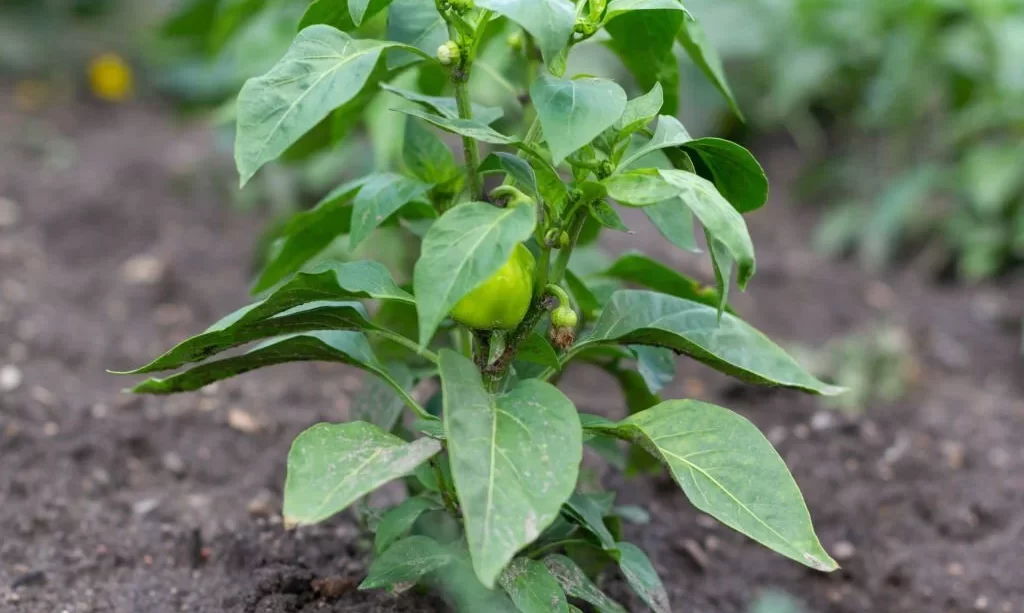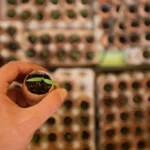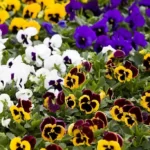Growing bell peppers from store-bought ones can be a fulfilling journey for any garden enthusiast. It’s a rewarding experience that not only saves you money but also brings the joy of savoring your homegrown peppers. Imagine plucking vibrant, crisp bell peppers straight from your garden and adding them to your favorite dishes – it’s a taste that’s hard to beat. In this guide, we’ll walk you through the steps, starting with the crucial task of selecting the right bell peppers from the grocery store. This simple act is the first step toward creating a thriving pepper garden that will keep you supplied with fresh and delicious peppers throughout the growing season.
- Produces Vibrant and Flavorful Bell Peppers
- Perfect for Salads, Stir-fries, and More !
- Guarenteed Live Arrival
- 2 Business Day Delivery For Most States.
Selecting the Right Bell Peppers
When it comes to growing bell peppers from store-bought peppers, your journey begins right in the produce aisle. The first thing you’ll want to do is carefully select the bell peppers that will serve as the source of your seeds. Here are some key considerations:
- Look for Healthy Specimens: Opt for peppers that are free from blemishes, soft spots, or mold. Healthy peppers are more likely to produce viable seeds.
- Choose Ripe Peppers: Select ripe bell peppers as they tend to have mature seeds. These are the seeds that are most likely to grow into strong pepper plants.
- Variety Matters: Keep in mind that the variety of bell pepper you choose will determine the color and flavor of your future peppers. Common varieties include green, red, yellow, and orange. Select the ones that appeal to your taste.
By choosing the right bell peppers at the store, you’re setting the foundation for a successful pepper-growing adventure. These peppers will be the starting point for extracting and planting your seeds, which we’ll delve into in the following sections.
Preparing the Seeds
Once you’ve chosen the perfect bell peppers from the store, it’s time to prepare the seeds for planting. Here’s how you can go about it:
- Seed Extraction: Begin by cutting the selected bell peppers in half. Gently remove the seeds and surrounding pulp. You can do this by scooping them out with a spoon. Try to be as gentle as possible to avoid damaging the seeds.
- Cleaning and Drying: Place the extracted seeds in a bowl of water. Swirl them around to separate any remaining pulp. Then, strain the seeds and spread them out on a paper towel to dry. Make sure they are completely dry before moving on to the next step.
- Test for Viability: To increase your chances of success, perform a simple viability test. Place a few dried seeds in a damp paper towel and seal them in a plastic bag. After a few days, check for germination. This helps you identify seeds that are likely to sprout.
With your bell pepper seeds now clean, dry, and tested, you’re ready to move on to the next phase: germination.
- Package includes about 40 seeds
- Instructions in English are included
- Season of Interest: Spring, Summer, Autumn
- USDA Hardiness Zone: 1-11
- Species: Capsicum annuum; Germanation: 90-95%
Germination Process
Germinating bell pepper seeds is a crucial step in their journey from grocery store produce to thriving garden plants. Here’s how to get it right:
- Seed Trays or Pots: You can use seed trays or small pots to start the germination process. Fill them with a high-quality seed starting mix. Make small holes about ¼ inch deep for planting the seeds.
- Planting the Seeds: Place one or two seeds in each hole. Cover them with soil and gently pat it down. Keep in mind that bell pepper seeds need warmth to germinate, so maintain a temperature around 75-85°F (24-29°C).
- Moisture and Covering: Water the soil lightly to keep it consistently moist, but not waterlogged. You can cover the seed tray or pot with a plastic lid or a plastic wrap to create a mini greenhouse effect. This helps retain moisture and warmth.
- Patience is Key: Be patient during the germination period, which typically takes 7-14 days. Once you see tiny seedlings emerging, it’s time to move on to the next step: transplanting them into larger pots or your garden.
Transplanting Seedlings
As your bell pepper seedlings grow, they’ll need more space to thrive. Here’s how to successfully transplant them:
- Timing is Crucial: Wait until your seedlings have at least two sets of true leaves before transplanting them. This usually occurs when they are 2-3 inches tall.
- Choosing a Location: Whether you’re transplanting into larger pots or your garden, select a sunny spot with well-draining soil. Bell peppers love sunlight, so aim for at least 6-8 hours of direct sunlight daily.
- Proper Spacing: If you’re planting in the garden, space your bell pepper seedlings 18-24 inches apart to allow for adequate growth. If using pots, choose containers that are at least 5 gallons in size to accommodate the root system.
- Careful Transplanting: Gently remove the seedlings from their initial containers, being careful not to damage the roots. Dig holes in the soil that are deep enough to cover the seedlings’ roots completely.
By following these steps, you’ll ensure a smooth transition for your bell pepper seedlings as they continue to grow into healthy, productive plants. In the next sections, we’ll explore how to care for your pepper plants and ultimately enjoy the fruits of your labor.
- Two (2) large live plants – big, healthy, ready to grow, premium pepper plants, 4” to 8” tall plants, in 4” pots. NON GMO No Neonicotinoids
- King Arthur plants produce big, blocky peppers up to five-inches wide! Sweet and crisp they are delicious eaten raw, in salads, on sandwhiches, or roast or saute. Peppers get sweeter as they go from green to red
- Season longh harvest. Sturdy plants grow up to 22-inches high, produces early, and keeps going all summer long. 10x Root Development means these plants grow stronger right from the startrepellent
- Grown in the Midwest. Plant in any US Zone. Plant in containers, small spaces, balconies, patios or large gardens. Benefits from caging or staking. Treat as a tender annual in Zones 9 and colder
- Careful Packaging. Your fresh plants arrive quickly in our exclusive, eco-friendly, 100% recyclable box. 100% Satisfaction Guarantee. Includes our Clovers Garden copyrighted Quick Start Planting Guide
Caring for Bell Pepper Plants
Taking care of your bell pepper plants is essential to ensure a bountiful harvest. Here are some key aspects of their care:
- Watering: Bell peppers prefer consistent moisture but don’t like to be waterlogged. Water deeply when the soil is dry to the touch, and avoid wetting the leaves to prevent diseases.
- Fertilizing: Use a balanced fertilizer to provide essential nutrients to your plants. Begin fertilizing when the first flowers appear and continue every 4-6 weeks throughout the growing season.
- Pest Control: Keep an eye out for common pests like aphids and caterpillars. Use organic pest control methods such as neem oil or insecticidal soap to protect your plants.
- Supporting Your Plants: As your bell pepper plants grow, they may become top-heavy with fruit. Use stakes or cages to support the branches and prevent them from bending or breaking.
- Pruning: To promote healthier growth, consider pruning your plants by removing any yellowing or diseased leaves. This allows the plant to direct its energy toward producing peppers.
By providing your bell pepper plants with the care they need, you’ll increase your chances of a successful harvest.
- PEPPER & HERB FERTILIZER: Greenway Biotech can make up to 200 gallons of liquid Pepper & herb 11-11-40 Plus Trace Minerals fertilizer. This fertilizer is formulated to provide a balanced ratio of nutrients essential for pepper plant
- HYDROPONIC SYSTEM: Pepper fertilizer is great for both Hydroponics and Soil Use. While the best pepper plant fertilizer depends on soil condition and the gardener’s preference, the top performer is Pepper & Herb Fertilizer. Plants need nutrients rich soil to grow well
- QUALITY INGREDIENTS: Greenway Biotech’s is perfectly blended to provide a balanced ratio of 11% nitrogen, 40%potassium, 11% phosphorus, Boron, Copper EDTA, Iron EDTA, Manganese EDTA, Zinc EDTA, and Molybdenum to your pepper plant fertilizer
- HEALTHY SOIL: This Input improves aeration in the root zone the texture and structure of the soil to allow the plant to grow better and ensure your plants are always radiant, healthy and delicious vegetables.
- 100% NATURAL: Naturally, it’s free of heavy metals and Materials, and its 100 % water soluble plant fertilizer as it is composed of the various micronutrients and Trace Minerals. It completely dissolves in water with no fallout
Harvesting and Enjoying Homegrown Bell Peppers
The moment you’ve been waiting for is here – it’s time to harvest and enjoy your homegrown bell peppers:
- Harvesting Time: Bell peppers can be harvested at different stages of ripeness. For green peppers, pick them when they reach full size and have a glossy appearance. For sweeter peppers (red, yellow, or orange), wait until they change color and become fully ripe.
- Harvesting Technique: Use garden shears or a sharp knife to cut the peppers from the plant. Make clean cuts to avoid damaging the plant.
- Post-Harvest Storage: Store harvested bell peppers in the refrigerator, preferably in a perforated plastic bag. They can last for up to two weeks when stored properly.
- Enjoying Your Harvest: Incorporate your homegrown bell peppers into various dishes, from salads to stir-fries. Their fresh, crisp flavor will enhance your culinary creations and provide a sense of accomplishment.
Conclusion
Growing bell peppers from store-bought peppers is a gratifying adventure that transforms a simple grocery item into a thriving garden. From carefully selecting the right peppers to harvesting the fruits of your labor, this journey allows you to savor the taste of your own homegrown produce. By following the steps outlined in this guide, you can embark on a rewarding gardening experience that not only saves you money but also brings the joy of cultivating and enjoying fresh, flavorful bell peppers. So, why wait? Start your bell pepper garden today and savor the satisfaction of homegrown goodness.







